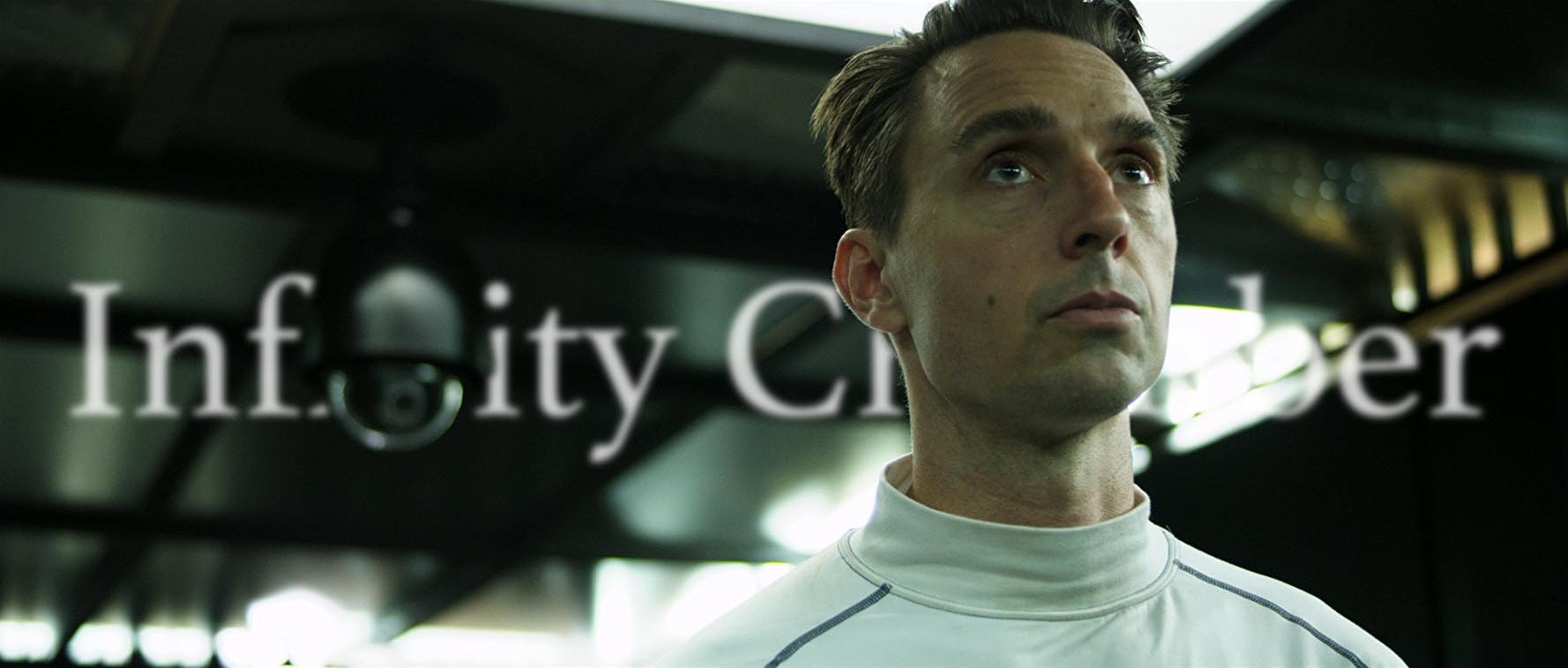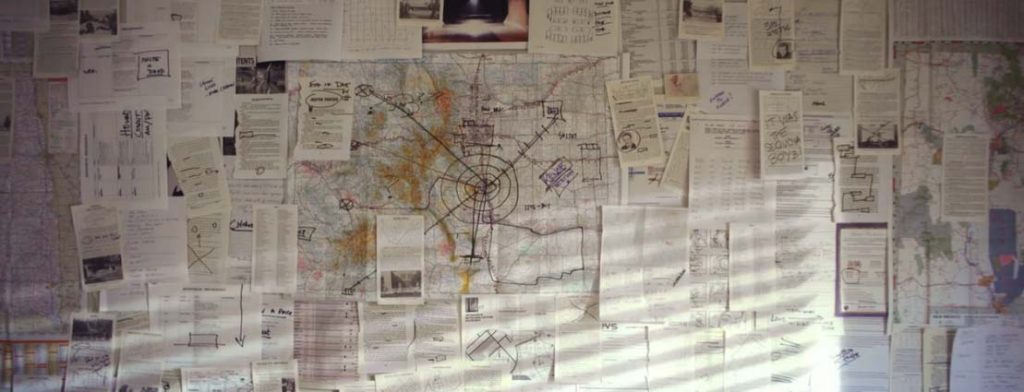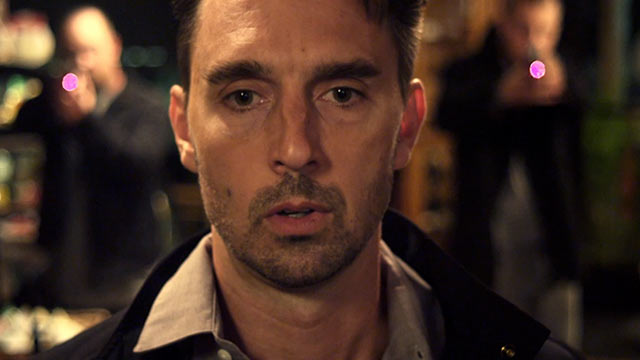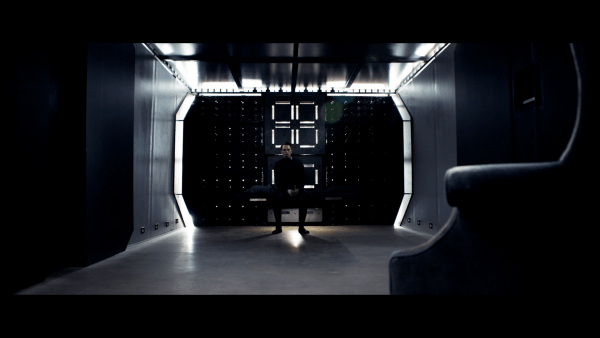Infinity Chamber Is a Fantastic Closed Box Mindjob
I’m on record as being one of seven people that adores closed box movies. Better known as plays on film. Why? Because they deal with ideas over special effects. They deal with dialogue over super powers. I love closed box movies because your screenplay author is guaranteed to have a clue how to fill 90 minutes of movie that most movies with special effects do not know how to fill. Well, Infinity Chamber is one of those movies wherein the screenplay author, Travis Milloy, definitely knows how to fill 100 minutes of your life in an extremely thorough and well thought out way. So why don’t we dive into why Infinite Chamber is a fantastic closed box Kafka-esque mindjob?
Infinity Chamber literally is a modern version of Franz Kafka’s novel The Trial, wherein a man is told that he has committed crimes, but not what they are. In Infinity Chamber, Frank Learner (Franz Kafka – Frank? No? Am I reaching?) has been detained, but isn’t told why. He also has amnesia of some sort and can’t remember really how he got there or much about his life before being brought to detention. Infinity Chamber is all about Frank, attempting to learn how he got there, and get out if he can manage it.
High Level Infinity Chamber Walkthrough
Frank Learner is trapped. He doesn’t 100% know the full extent of his entrapment, but he’s trapped. He hasn’t been told his crime, or suspicion of a crime. He’s not been given a reason for his detainment. And the one person that knows he’s been imprisoned… isn’t a person at all. And as Frank begins to learn more and more about his predicament (see what I did there? Frank Learner? Is learning? Haha!) the more he begins to grasp the severity of his problem.
And as the story slowly advances, and our understanding grows, most of our real learning comes from Frank flashing backwards to his life before his detainment. We see a world in trouble and at war. We see security forces rooting out rebels. We hear about the risk and the threat of war.
Infinity Chamber Howard Conversation
One of the most compelling elements of Infinity Chamber is conversation between Frank and his LSO, his Life Support Operator. His LSO’s name is Howard. At first, (literally the first 20 minutes) the conversation is between Frank and a guy behind a security camera that is required to keep Frank alive and make sure that he is processed. And then he realizes that Howard is a computer program, and not a person at all. These conversations are pretty good, and it intrigues me that a screenwriter can take a closed box situation like this one, and imbue it with enough heft and meaning so as to be interesting. I mean, tabula rasa? It’s amazing to me. But it is a big part of the reason why this film works. That and the fact that there are layers and layers of recursive meaning.
Infinity Chamber And “The Device” Discussed
Eventually, the power shuts down. And with the power, goes Howard. But the place of Howard is replaced by a cellmate next door named Fletcher May. Fletcher, it would appear, is the head of the resistance group to the ISN. The rebels have been looking for ways to take down the ISN. To revolt. And Fletcher said that his plan was to hit the power supplies in order to cause the entire system to come crashing down.
As Frank and Fletcher continue to talk, one of the most important revelations is that the spinning device in the cell is attempting to hack into their consciousness. Trying to get at a secret, or some sort of information. And the only way to keep that from them is to hide the information in a common story, or memory. But to alter the memory just a little bit so that as the device scans through their neural network, it is always ending up in the right house, but always the wrong room.
Which, creates a problem for us, the viewer. If “The Device” is able to scan and trace neural pathways, to visit, and revisit rooms of memory… could this entire movie be one big memory dance between the ISN and Frank? Huh. Interesting thought. We should keep an eye on that…
Gabby’s Ongoing Conversation with Frank
As Frank sleeps, at least in the beginning anyway, he has this recurring memory of starting his day, and then going to a coffee shop to talk with the owner, named Gabby. Each encounter is basically the same, as we learn new details the more we repeat the encounter. Eventually we learn that each time someone buys something in the shop, the ISN scans the room, ISN security comes in, tasers Frank, and he awakens back in his cell again. Then the power goes out, and it seems as is if Gabby remembers him. Something has progressed in the dream state.
And somewhere around the hour mark, we get a montage of recurring days, and they culminate with Gabby and Frank ambushing the two agents. But Frank realizes that the agents don’t know anything. They are only in his memory anyway. But Gabby and Frank’s relationship continues progressing. Their knowledge of the problem is progressing. They have begun charting and tracking and logging everything. And Howard’s reset intervals? They are becoming shorter and shorter, and so Frank decides today is the day that they make a big move against Howard.
So Frank uses one of these resets to put a bag over Howard’s head, and then escape when the robot comes in to make sure Frank is OK.
The External Excursions of Infinity Chamber
In excursion #1 – Frank escapes out of a manhole portal that rests on the desert floor. Frank finally crosses the desert to a road, and then over to a gas station. And there in the gas station, to his horror, he sees Gabby’s photographs on the wall, and the normal coffee shop music playing. And he wakes back in the detention center all over again.
In excursion #2 – After waking back in the chamber, Howard asks if Frank would like to have coffee. And Frank responds with, ‘There is no coffee.’ Indicating that Frank believes that even the chamber is in his own mind. That the cell isn’t even real. That Frank was a part of the alliance… not only that, but Frank was the one that built the virus that would crash the whole system. In the second escape, Frank attempts suicide, only to survive, and escape back out through the door again. Frank makes it to the control panel for Howard, and he shuts him down. He then heads out through the manhole cover again, only to find snow… and mountains. He finds himself being rescued by two other hikers.
Literal Theory to Explain Infinity Chamber
The movie gives a number of possible threads that we can follow to explain this movie. The literal theory utilizes the ending wrap up details to come to a conclusion of what happened. Basically, Frank was a member of a 300 person elite forced that was captured and trapped in a detention facility. All of these facilities were black ops centers operated off the radar, and sustained through wind turbine power. All the other detainees were found dead when the locations were searched after Frank was released.
Literal Theory to Explain Infinity Chamber Redux
Redux assumes that the literal theory is correct. The only significant change being? He actually didn’t escape with his last run through the snow and the mountains. Right? Who’s to say that Gabby (aka Madelyn, apparently we’ve had her name wrong all along?) and Frank are not going to snap out of their beginning introductions the moment he buys coffee again? Sure, we got a little more backstory about the 300 insurgents… but that is just The Device being ultra clever in its hunting down for the virus. Think about it, why was the thumb drive behind the photograph? Why did he know anything at all about Gabby? (Or that Gabby ever worked there?) Better yet? How could he envision a real place from the confines of his mind-cell if he had never been there. Just the fact alone that he got all those details right basically proves he hasn’t escaped to freedom.
Life Support Theory Explaining Infinity Chamber
Another thread that runs through Infinity Chamber is the idea that not all things should be modernized and automated. When Frank tells this to Howard, he gives him a story about his father to explain his point. His father, apparently, lived 4 years past when he had made his peace, but a machine was put in place to keep him alive.
This theory believes that Frank isn’t military personnel, trapped in an underground bunker. But rather, Frank is dying. Frank is just continuing to struggle with the idea that he should have died several years ago. But instead, he fights and looks for a way to get out of his eternal torment against his will.
The gorgeousness of this theory? It could include the previous two theories with one simple tweak. What if the LSO (Life Support Officer) is actually capable of injecting thoughts into the patients mind to keep them docile and active. This is a new form of entertainment. The ability to play mental spy games in your mind? And not only that, but it keeps these patients from understanding what is really happening to them… and that is? Dying.
The Kafka Parable of Infinity Chamber Theory
What about a theory that ditches the past three theories entirely? What if Infinity Chamber is just a modern day retelling of Kafka’s The Trial? If you are unfamiliar with The Trial, it’s a simple enough narrative to understand – if a highly complicated philosophical idea. Basically K is informed he is in trouble with the state, and the police. He learns he will be heading to trial, but is never informed as to why, for what. And Kafka has done an amazing job in absolutely avoiding discussing specific charges throughout the entirety of the book. While discussing his culpability with the Judge, the police, random people… the specific charges never are addressed. And even when K is executed, we are still wondering.
And hold on, K doesn’t even get a trial! The book is mainly one big bureaucratic delay after bureaucratic delay. The book is filled with K’s ruminations on justice, totalitarianism, art, love, but we get next to nothing on why he is going to be on trial. And all the while, K begins to admit various and sundry crimes to himself… and starts to come around on his own guilt. Which, in my opinion, was the story of the novel. I’ve done nothing, to – I might have done something, to – yeah, definitely, I am 100% guilty. And really with that, and without a trial, K is marched to a quarry outside of town by two men that seem to be heading to the opera for the evening.
Which, brings us back Infinity Chamber. Frank is locked up, without any indication of why. He is held without any human interaction. And he is subjected to persistent and constant interrogations that he isn’t even informed of. We eventually learn that Frank may very well have been a member of an uprising that was attempting to overthrow the current government. And so we are doing better at least than K did. But still, it is the discussion of the government abilities to infringe on our rights without any sort of due process. Or maybe he’s just trapped in a life support system. Who knows?
Final Thoughts on Infinity Chamber
I watched this movie over a year ago. It had just come out. And I quickly ran to do a review and discussion of it. Only problem? I was in the middle of a big upgrade for the site, and mid-transition, I lost the review. It was up for about a week, and then was gone. (Almost like a scene straight out of the movie! Gah!) But this time, when I went back to the film, just to grab a few reminders of how the plot goes, I ended up rewatching it from the beginning, without skipping a moment. Now, you have to understand, that that is very very rare for me. So I must have really enjoyed the unfolding story that evolved and grew along the way. I enjoyed the dialog and the ducking and weaving of this really evasive story. And to this day, I still don’t know which theory I would go with if pressed. I’m thinking that he definitely isn’t free. And I tend to believe that maybe he is dying, and being tended to by a life support program of some sort. But I don’t know. Theory 2 doesn’t explain the real world section of the movie. But theory three does. So yeah, I’m guessing that is what I would go with if pushed.
But I don’t know, what other theories can you come up with from the film? There have got to be more that could explain this layered and multifaceted film!
Edited by, CY





